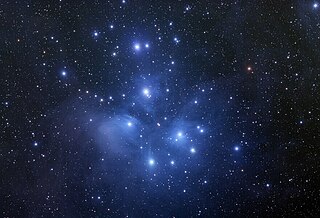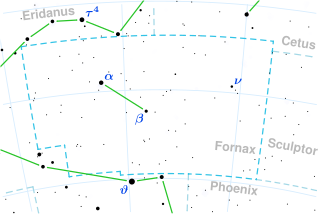Related Research Articles
10 Boötis is a suspected astrometric binary star system in the northern constellation of Boötes, located around 528 light years away from the Sun. It is visible to the naked eye under suitable viewing conditions as a dim, white-hued star with an apparent visual magnitude of 5.76. Its magnitude is diminished by an extinction of 0.17 due to interstellar dust. This system is moving away from the Earth with a heliocentric radial velocity of +6 km/s.
5 Cancri is a single star in the zodiac constellation of Cancer, located around 520 light years away from the Sun. It is just visible to the naked eye under good seeing conditions as a dim, blue-white hued star with an apparent visual magnitude of 5.99. This object is moving closer to the Sun with a heliocentric radial velocity of −10 km/s.
66 Cancri is a binary star system near the northern border of the zodiac constellation of Cancer, located 474 light years away from the Sun. It is visible to the naked eye as a faint, white-hued star with a combined apparent visual magnitude of 5.87. The pair are moving closer to the Earth with a heliocentric radial velocity of −13 light years. As of 2003, the magnitude 8.56 companion was located at an angular separation of 4.43″ along a position angle of 134° from the primary.
Rho2 Cephei, Latinized from ρ2 Cephei, or simply ρ Cephei, is a solitary star in the northern constellation of Cepheus. With an apparent visual magnitude of 5.50, it is faintly visible to the naked eye, forming an optical pair with Rho1 Cephei. Based upon an annual parallax shift of 13.31 mas as seen from the Earth, it is located about 245 light years from the Sun.
42 Camelopardalis is a single star in the constellation Camelopardalis, located roughly 770 light years away from the Sun. It is visible to the naked eye as a faint, blue-white hued star with an apparent visual magnitude of 5.14. The visual magnitude of the star is diminished by an extinction of 0.22 due to interstellar dust. It is moving further from the Earth with a heliocentric radial velocity of 3 km/s. 42 Camelopardalis has a peculiar velocity of 24.4+1.9
−2.1 km/s and may be a runaway star.
HD 69863 is a binary star system in the southern constellation of Carina. It is visible to the naked eye as a dim point of light with a combined apparent visual magnitude of 5.16. The system is located at a distance of about255 light years from the Sun based on parallax. The dual nature of this system was announced in 1832 by German astronomer Carl Rümker. As of 2015, the pair had an angular separation of 4.10″ along a position angle of 70°.

ι Lyrae, Latinised as Iota Lyrae, is a binary star in the northern constellation of Lyra. It is visible to the naked eye as a dim, blue-white hued star with an apparent visual magnitude that fluctuates around 5.22. This object is located approximately 910 light years distant from the Sun based on parallax, but is drifting nearer with a radial velocity of −26 km/s.

HD 204521 is a star in the northern constellation of Cepheus. In the sky it positioned just to the west of the magnitude 3.2 star Beta Cephei. This object has a yellow hue similar to the Sun but is too faint to be visible to the naked eye with an apparent visual magnitude of 7.26. It is located at a distance of 86 light years from the Sun based on parallax, and has an absolute magnitude of 5.15. The star is drifting closer with a radial velocity of −77 km/s, and is predicted to come to within 7.96 light-years in 334,000 years. At that distance the star can have a relatively small perturbing effect on comets in the Oort cloud.

Omega1 Cygni, Latinized from ω1 Cygni, is the Bayer designation for a solitary star in the northern constellation of Cygnus. It is visible to the naked eye with an apparent visual magnitude of 4.94. Based upon an annual parallax shift of 2.59 mas, it is estimated to lie roughly 1,260 light years from the Sun. Relative to its neighbors, this star has a peculiar velocity of 25.7±2.2 km/s.
HD 125442 is a single star in the southern constellation of Lupus. Its apparent visual magnitude is 4.78, which can be seen with the naked eye. The distance to HD 125442, as determined from its annual parallax shift of 22.1 mas, is 147 light years.

ν Pegasi, Latinized as Nu Pegasi is a single star in the northern constellation of Pegasus. It is an orange-hued star that is faintly visible to the naked eye with an apparent visual magnitude of 4.84. The star is located approximately 261 light years away based on parallax, but is drifting closer with a radial velocity of −19 km/s.

ET Virginis is a single, red-hued star in the equatorial constellation of Virgo. It can be viewed with the naked eye, having an apparent visual magnitude of 4.91. Based upon an annual parallax shift of 5.9 mas, it is located 560 light years away. It is moving further from the Earth with a heliocentric radial velocity of +18.6 km/s, having come within 177 ly of the Sun around 6.3 million years ago.
HD 83446 is a probable astrometric binary star system in the constellation Vela. It is visible to the naked eye with an apparent visual magnitude of 4.34. Based upon an annual parallax shift of 30.5 mas, it is located 107.1 light years from the Sun. The system is moving further away with a heliocentric radial velocity of +18 km/s.

31 Persei is a single star in the northern constellation of Perseus. It is visible to the naked eye as a dim, blue-white hued point of light with an apparent visual magnitude of 5.05. This star is located around 172 parsecs (560 ly) away from the Sun, and it is drifting closer with a radial velocity of −1.6 km/s. It is likely a member of the Alpha Persei Cluster.

HD 23753 is a single star in the equatorial zodiac constellation of Taurus, and is a member of the Pleiades open cluster. It is dimly visible to the naked eye with an apparent visual magnitude of 5.44. The distance to this star, as determined from its annual parallax shift of 7.7 mas, is about 420 light years. It is moving further from the Earth with a heliocentric radial velocity of +8 km/s. The star is positioned near the ecliptic and so is subject to lunar occultations.

Upsilon Coronae Borealis, Latinized from υ Coronae Borealis, is a solitary star in the northern constellation of Corona Borealis. It is a white-hued star that is dimly visible to the naked eye with an apparent visual magnitude of 5.78. The distance to this object is approximately 630 light-years based on parallax.

BW Vulpeculae or BW Vul, is a variable star in the northern constellation of Vulpecula. It is near the lower limit of visibility to the naked eye with a typical apparent visual magnitude of 6.54. Based on an annual parallax shift of 1.15 mas, the distance to BW Vul is about 2,800 light years. It is moving closer to the Earth with a baseline heliocentric radial velocity of around −6 km/s.

Gamma2 Fornacis, a name Latinized from γ2 Fornacis, is a single star in the southern constellation Fornax. It has a white hue and is faintly visible to the naked eye at night with an apparent visual magnitude of 5.4. The distance to Gamma2 Fornacis is approximately 520 light years based on parallax. It is drifting further away with a radial velocity of 24 km/s. Gamma1 Fornacis is a 6th magnitude star about four degrees to the north.
HD 53501, is a solitary star in the southern circumpolar constellation Volans. It has an apparent magnitude of 5.18, allowing it to be seen with the naked eye under ideal conditions. The object is located at a distance of 308 light years but is receding with a heliocentric radial velocity of 39 km/s.
HD 46815 is a solitary star in the southern constellation Columba. It is faintly visible to the naked eye with an apparent magnitude of 5.4 and is estimated to be 408 light years away. However, it is receding with a heliocentric radial velocity of 32.2 km/s.
References
- 1 2 3 4 5 Brown, A. G. A.; et al. (Gaia collaboration) (August 2018). "Gaia Data Release 2: Summary of the contents and survey properties". Astronomy & Astrophysics . 616. A1. arXiv: 1804.09365 . Bibcode: 2018A&A...616A...1G . doi: 10.1051/0004-6361/201833051 . Gaia DR2 record for this source at VizieR.
- 1 2 3 4 Anderson, E.; Francis, Ch. (2012), "XHIP: An extended hipparcos compilation", Astronomy Letters, 38 (5): 331, arXiv: 1108.4971 , Bibcode:2012AstL...38..331A, doi:10.1134/S1063773712050015, S2CID 119257644.
- 1 2 3 4 5 6 7 8 9 Zorec, J.; et al. (2012), "Rotational velocities of A-type stars. IV. Evolution of rotational velocities", Astronomy and Astrophysics, 537: A120, arXiv: 1201.2052 , Bibcode:2012A&A...537A.120Z, doi:10.1051/0004-6361/201117691, S2CID 55586789.
- 1 2 Lesh, Janet Rountree (December 1968), "The Kinematics of the Gould Belt: an Expanding Group?", Astrophysical Journal Supplement, 17: 371, Bibcode:1968ApJS...17..371L, doi: 10.1086/190179
- ↑ Gontcharov, G. A. (November 2006), "Pulkovo Compilation of Radial Velocities for 35495 Hipparcos stars in a common system", Astronomy Letters, 32 (11): 759–771, arXiv: 1606.08053 , Bibcode:2006AstL...32..759G, doi:10.1134/S1063773706110065, S2CID 119231169.
- 1 2 Pasinetti Fracassini, L. E.; et al. (February 2001), "Catalogue of Apparent Diameters and Absolute Radii of Stars (CADARS)", Astronomy and Astrophysics, 367 (2) (Third ed.): 521–524, arXiv: astro-ph/0012289 , Bibcode:2001A&A...367..521P, doi:10.1051/0004-6361:20000451, S2CID 425754.
- 1 2 Niemczura, E. (June 2003), "Metallicities of the SPB stars from the IUE ultraviolet spectra", Astronomy and Astrophysics, 404 (2): 689–700, Bibcode:2003A&A...404..689N, doi: 10.1051/0004-6361:20030546
- ↑ Gullikson, Kevin; et al. (2016), "The Close Companion Mass-Ratio Distribution of Intermediate-Mass Stars", The Astronomical Journal, 152 (2): 40, arXiv: 1604.06456 , Bibcode:2016AJ....152...40G, doi: 10.3847/0004-6256/152/2/40 , S2CID 119179065.
- ↑ "7 Cep". SIMBAD . Centre de données astronomiques de Strasbourg . Retrieved April 25, 2019.
- ↑ Eggleton, P. P.; Tokovinin, A. A. (September 2008), "A catalogue of multiplicity among bright stellar systems", Monthly Notices of the Royal Astronomical Society , 389 (2): 869–879, arXiv: 0806.2878 , Bibcode:2008MNRAS.389..869E, doi: 10.1111/j.1365-2966.2008.13596.x , S2CID 14878976.
- ↑ Burggraaff, O.; et al. (September 2018), "Studying bright variable stars with the Multi-site All-Sky CAmeRA (MASCARA)", Astronomy & Astrophysics, 617: 11, arXiv: 1806.02247 , Bibcode:2018A&A...617A..32B, doi:10.1051/0004-6361/201833142, S2CID 84836583, A32.